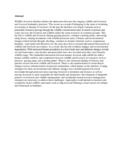| dc.contributor.author | Muchemi, G M | |
| dc.date.accessioned | 2014-07-11T07:29:39Z | |
| dc.date.available | 2014-07-11T07:29:39Z | |
| dc.date.issued | 2010-09 | |
| dc.identifier.citation | Muchemi,G.M.,September,2010.Wildlife-Livestock Interface In A Changing Environment,Department of Public Health Pharmacology and Toxicology, College of Agriculture and Veterinary Sciences, University of Nairobi. | en_US |
| dc.identifier.uri | http://hdl.handle.net/11295/72673 | |
| dc.description.abstract | Wildlife-livestock interface defines the interaction between free ranging wildlife and livestock and livestock husbandry practices. This occurs as a result of belonging to the same or bordering ecosystems or sharing of resources. In the past the interface was largely transient such as pastoralist livestock passing through the wildlife concentration areas in search of pasture and water, but now the livestock and wildlife utilize the same resources in common grounds. This has led to wildlife and livestock sharing grazing pastures, common watering points, interacting along fences, sharing boundaries with wildlife protected areas. Climatic and environmental changes which include drought, flooding, variation in climatic elements such as, temperature, humidity, wind speed and direction over the years have led to seasonal and annual fluctuations in wildlife and livestock movements. As a result, this has led to habitat changes and environmental degradation. With increased human population in a fixed land mass and inherent changes in land use and land tenure, crop farmers and pastoralists have now invaded areas that were formerly wildlife range. This intensified interaction between human, livestock and wildlife has led to human wildlife conflicts and competition between wildlife and livestock for resources such as pastures, grazing range and watering points. There is also increased sharing of diseases and parasite vectors between wildlife and livestock. There is also manifestation of sociocultural changes such as sedenterization of pastoral communities which impact on the interface. Coping strategies for these environmental and climatic changes have included pastoral livestock movement through protected areas exposing livestock to predation and diseases as well as moving livestock to areas unsuitable for their health and production. Development of adaptable policies on livestock and wildlife management, and sustainable natural resource management strategies are necessary to address these challenges. Approaches could include ecotourism and community based wildlife sanctuaries such as Ilngwesi and Naibunga conservancies in Laikipia and Namunyak in Samburu. | en_US |
| dc.language.iso | en | en_US |
| dc.publisher | University of Nairobi | en_US |
| dc.subject | Wildlife, Livestock, Interface, Changes | en_US |
| dc.title | Wildlife-Livestock Interface In A Changing Environment | en_US |
| dc.type | Presentation | en_US |
| dc.type.material | en | en_US |

